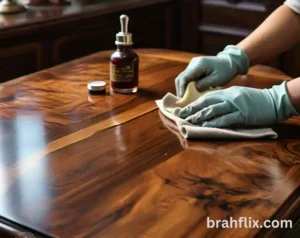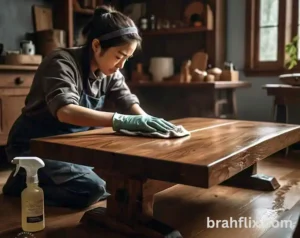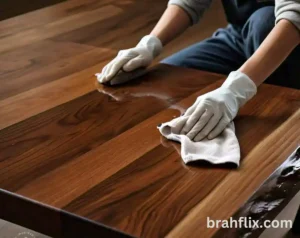Introduction
Wooden tables add a touch of elegance and warmth to any space, but their beauty can be compromised by unsightly stains. Whether caused by spills, heat, or other accidents, stains can detract from the table’s appearance and potentially damage the wood if not addressed promptly. Learning how to clean a wooden table with stains is essential for preserving the table’s natural luster and ensuring its longevity. This guide provides a comprehensive overview of effective cleaning methods, practical tips, and preventative measures to help you maintain a pristine wooden table.
Key Takeaways:
- Identify different types of stains and appropriate cleaning methods for each.
- Utilize household and natural cleaning solutions for effective stain removal.
- Implement preventive measures to avoid future stains and maintain the table’s appearance.
1. Identifying Common Types of Stains on Wooden Tables
Before tackling a stain, it’s important to identify its type. Different stains require specific cleaning methods to effectively remove them without damaging the wood.
Types of Stains:
- Water Stains: Often appear as white rings or spots on the surface due to moisture penetration.
- Oil and Grease Stains: Result from food, cooking oils, or greasy hands and can leave dark, sticky marks.
- Ink Stains: Typically deep and dark, these are caused by spilled ink or writing utensils.
- Food and Beverage Stains: These can vary in color and can include anything from red wine to soy sauce.
- Heat Marks: White or light rings caused by placing hot dishes or mugs directly on the wood.
Understanding Stain Types:
Identifying the stain type is crucial for choosing the right cleaning approach and achieving the best results.
2. Essential Supplies for Cleaning Stained Wooden Tables
Having the right tools and supplies at your disposal can make the cleaning process more effective and less time-consuming. Here’s a list of essential supplies:
Basic Cleaning Supplies:
- Soft Cloths: Microfiber cloths are ideal as they are gentle on wood surfaces and effective at picking up dust and residue.
- Mild Dish Soap: Useful for creating a gentle cleaning solution for most stains.
- White Vinegar: An effective natural cleaner that can help dissolve stains and neutralize odors.
- Baking Soda: Acts as a mild abrasive and deodorizer for tougher stains.
- Wood Polish: Helps restore shine and protect the table after cleaning.
Specialized Cleaning Products:
- Wood Cleaner: Formulated specifically for wooden surfaces to clean without damaging the finish.
- Wood Conditioner: Helps nourish the wood and maintain its natural oils.
Tip:
Always test cleaning products on a small, inconspicuous area before using them on the entire stain to ensure compatibility with your table’s finish.
3. Cleaning Water Stains from Wooden Tables
Water stains, often seen as white rings or spots, can be particularly frustrating. Here’s a step-by-step guide to effectively removing them:
Steps to Clean Water Stains:
- Assess the Stain: Determine whether the water stain is superficial or has penetrated the wood. Superficial stains are easier to treat.
- Use Heat: Place a clean, dry cloth over the stain. Gently rub the cloth with a warm iron set to low heat. The heat can help lift the moisture from the wood.
- Apply Baking Soda Paste: If heat alone doesn’t work, mix baking soda with a small amount of water to form a paste. Apply it to the stain and gently rub with a soft cloth.
- Polish the Surface: Once the stain is removed, apply a wood polish to restore the table’s shine and protect the surface.
Recommendation:
For persistent stains, you may need to repeat the process or consult a professional for more severe cases.
4. Removing Oil and Grease Stains
Oil and grease stains can be challenging due to their sticky nature. Here’s how to handle them:
Steps to Remove Oil and Grease Stains:
- Blot the Stain: Use a paper towel or cloth to blot up any excess oil. Avoid rubbing, as this can push the grease further into the wood.
- Clean with Dish Soap Solution: Mix a few drops of mild dish soap with warm water. Dampen a cloth with the solution and gently clean the stained area.
- Rinse and Dry: Use a clean, damp cloth to rinse the area, then dry thoroughly with a lint-free towel.
- Polish the Table: Apply a wood polish to protect the surface and restore its appearance.
Tip:
For stubborn grease stains, you can use a mixture of white vinegar and baking soda. Apply the mixture, let it sit for a few minutes, then wipe clean.
5. Tackling Ink Stains on Wooden Surfaces
Ink stains can be particularly stubborn due to their deep color. Here’s a method for effective removal:
Steps for Ink Stain Removal:
- Blot the Ink: Gently blot the stain with a clean cloth or cotton ball to absorb as much ink as possible. Avoid rubbing to prevent spreading.
- Apply Rubbing Alcohol: Dampen a cotton ball or soft cloth with rubbing alcohol and gently blot the stain. Be cautious not to oversaturate the wood.
- Clean with Wood Cleaner: After the ink is removed, clean the area with a wood cleaner to remove any residual alcohol.
- Condition the Wood: Apply a wood conditioner to restore moisture and protect the surface.
Recommendation:
For old or stubborn ink stains, a commercial ink remover designed for wooden surfaces might be necessary.
6. Dealing with Food and Beverage Stains
Food and beverage stains vary widely and can be tricky to remove. Here’s a guide to handling these types of stains:
Steps to Clean Food and Beverage Stains:
- Blot the Spill: Immediately clean up spills with a damp cloth to prevent them from setting.
- Apply Vinegar Solution: Mix equal parts white vinegar and water. Apply this solution to the stained area using a soft cloth and rub gently.
- Rinse and Dry: Rinse the area with clean water and dry thoroughly with a lint-free towel.
- Polish the Table: After the stain is removed, apply a wood polish to protect and shine the surface.
Tip:
For sticky or tough stains, a paste of baking soda and water can be effective. Apply the paste to the stain, let it sit, then gently scrub and wipe clean.
7. Preventing Future Stains on Your Wooden Table
Preventive measures can help protect your wooden table from future stains and damage. Here’s how to safeguard your table:
Preventive Measures:
- Use Coasters and Placemats: Protect the table from drink rings and food spills by using coasters and placemats.
- Apply a Protective Finish: Consider applying a wood finish or protective coating to create a barrier against spills and stains.
- Clean Spills Immediately: Address any spills or stains as soon as they occur to prevent them from setting.
- Regular Dusting: Dust the table regularly to prevent grit from causing scratches and damage.
Tip:
For added protection, consider using tablecloths or runners, especially during meals, to shield the table from direct contact with food and beverages.
8. Repairing Minor Stains and Scratches
Even with preventive measures, minor stains and scratches can occur. Here’s how to address them:
Repair Methods:
- Wood Filler: For deeper stains or scratches, use a wood filler or crayon that matches the table’s finish. Apply according to the manufacturer’s instructions.
- Sanding and Polishing: Lightly sand the area with fine-grit sandpaper to smooth out the surface, then apply a matching wood polish or finish.
- DIY Solutions: For minor touch-ups, you can use a DIY mixture of olive oil and vinegar to condition and restore the table’s appearance.
Tip:
Always test repair products on a small, inconspicuous area before applying them to the visible surface.
9. Professional Cleaning and Restoration Services
For extensive or severe stains, professional cleaning and restoration services may be necessary. Here’s what to consider:
Benefits of Professional Services:
- Expertise: Professionals have the skills and tools to handle complex stains and restore the table’s finish effectively.
- Quality Restoration: They can perform detailed repairs, refinishing, and polishing to bring your table back to its original condition.
- Value Preservation: Professional restoration can help maintain or enhance the value of antique or high-end furniture.
Recommendation:
For valuable or antique tables, investing in professional services can ensure high-quality care and long-term preservation.
Frequently Asked Questions (FAQs)
1. How can I remove old or set-in stains from my wooden table?
For old stains, use a combination of vinegar and baking soda. Apply the paste to the stain, let it sit, then gently scrub and wipe clean.
2. Is it safe to use bleach on wooden tables for stain removal?
Bleach is not recommended for wooden surfaces as it can damage the wood. Stick to wood-specific cleaners and natural solutions.
3. How often should I apply protective coatings to my wooden table?
Apply protective coatings every 6-12 months or as needed based on usage and wear to maintain the table’s finish.
4. Can I use commercial stain removers on my wooden table?
Yes, but ensure the product is specifically designed for wooden surfaces and always test on a small area first.
5. What should I do if my wooden table has deep scratches in addition to stains?
For deep scratches, use a wood filler and sand the area before applying a matching finish. For extensive damage, consider professional restoration.
Conclusion
Cleaning and maintaining a wooden table with stains involves understanding the type of stain, using appropriate cleaning methods, and implementing preventive measures. By following the guidelines outlined in this article, you can keep your wooden table looking its best and extend its lifespan.
Have you faced any challenges with cleaning your wooden table? Share your experiences or questions in the comments below. For more tips on furniture care and maintenance, explore our other blogs and stay informed!